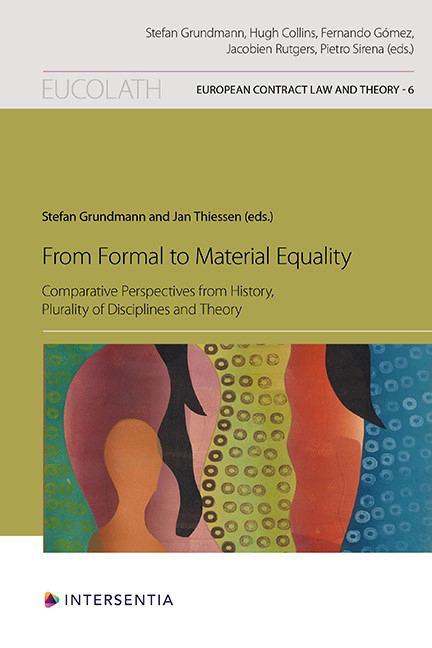 From Formal to Material Equality
From Formal to Material Equality Book contents
- Frontmatter
- Contents
- List of Authors
- From Formal to Material Equality: Key Insights from History and in a Multidisciplinary Perspective
- The Same Human Nature: Some Approaches to Equality in Law
- Two Centuries of Private Law Theory on Formal and Material Equality
- Equal Dignity of Human Beings: The Philosophical and Methodological Foundations of Private Law
- Equality Between Efficiency and Distribution: A Law and Economics Reconceptualisation of a Principle of Justice
- Dimensions of Equality in Private Law: Translating between Law, Society and Technology
- Index
- European Contract Law and Theory Series
Dimensions of Equality in Private Law: Translating between Law, Society and Technology
Published online by Cambridge University Press: 15 November 2023
- Frontmatter
- Contents
- List of Authors
- From Formal to Material Equality: Key Insights from History and in a Multidisciplinary Perspective
- The Same Human Nature: Some Approaches to Equality in Law
- Two Centuries of Private Law Theory on Formal and Material Equality
- Equal Dignity of Human Beings: The Philosophical and Methodological Foundations of Private Law
- Equality Between Efficiency and Distribution: A Law and Economics Reconceptualisation of a Principle of Justice
- Dimensions of Equality in Private Law: Translating between Law, Society and Technology
- Index
- European Contract Law and Theory Series
Summary
INTRODUCTION
The bearing of the principle of equality between private actors is yet to be adequately determined. Like the concept of justice itself, it must be separated from the dichotomy of iustitia distributiva and iustitia commutativa, which reflects the distinction between the State and society; between public and private relationships.
However, this reference to a dichotomy itself misses the point. Not only is a categorical division of the spheres of justice at odds with the actual structure of society and its proliferation into multiple subsystems, but it also reduces the right to equality to a mere instrument for the allocation of goods, to and between persons, across the board. Both the idea of an equal distribution of rights (in citizens’ relationships with each other), and the idea of an equal distribution of what is actually required to exercise such rights (a citizens’ claim against the State), miss the guarantee of freedom implied by these rights in general, and by the right to equality in particular. Both instances are based on an understanding of law that assimilates rights as possessions. From a procedural concept of law, this approach tends to “misunderstand the legal constitution of freedom as ‘ distribution’ and to assimilate it to the model of the equal distribution of acquired or allocated goods”. This characterisation implies a positivism of rights, legal entities, and rules of distribution, treating them all as pre-existing. The view of rights as an inventory of possessions and abilities ( “property”), implies a far reaching positivism, treating the individual, their goods, and the rules that apply to them as a given. This, almost inevitably, results in categorisation of rights in the relationship between private individuals as being rights of ownership or dominion, or exclusion rights; while the relationship between individuals and the State is framed as being characterised by rights of protection, or negative rights. But how can this be, if the individual cannot be assumed to be pre-existent? What, then, when options for action and communication do not yet exist, and must fi rst be generated?
Then, the law, including the right to equality, would have to be set to accommodate a potential mutual constitution of rights, personal identity, and social practice.
- Type
- Chapter
- Information
- From Formal to Material EqualityComparative Perspectives from History, Plurality of Disciplines and Theory, pp. 111 - 140Publisher: IntersentiaPrint publication year: 2023
